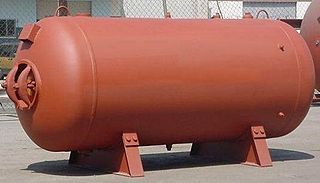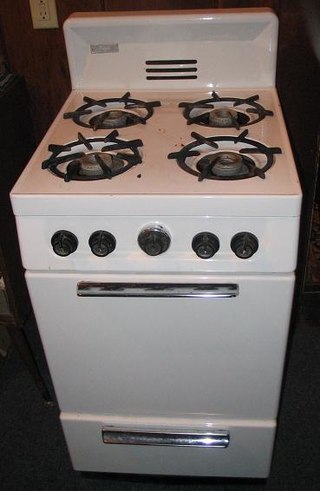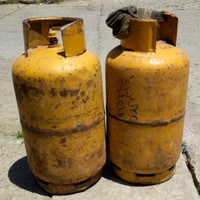
Propane is a three-carbon alkane with the molecular formula C3H8. It is a gas at standard temperature and pressure, but compressible to a transportable liquid. A by-product of natural gas processing and petroleum refining, it is often a constituent of liquefied petroleum gas (LPG), which is commonly used as a fuel in domestic and industrial applications and in low-emissions public transportation; other constituents of LPG may include propylene, butane, butylene, butadiene, and isobutylene. Discovered in 1857 by the French chemist Marcellin Berthelot, it became commercially available in the US by 1911. Propane has lower volumetric energy density than gasoline or coal, but has higher gravimetric energy density than them and burns more cleanly.

Isobutane, also known as i-butane, 2-methylpropane or methylpropane, is a chemical compound with molecular formula HC(CH3)3. It is an isomer of butane. Isobutane is a colorless, odorless gas. It is the simplest alkane with a tertiary carbon atom. Isobutane is used as a precursor molecule in the petrochemical industry, for example in the synthesis of isooctane.

A portable stove is a cooking stove specially designed to be portable and lightweight, used in camping, picnicking, backpacking, or other use in remote locations where an easily transportable means of cooking or heating is needed. Portable stoves can be used in diverse situations, such as for outdoor food service and catering and in field hospitals.

A lighter is a portable device which uses mechanical or electrical means to create a controlled flame, and can be used to ignite a variety of flammable items, such as cigarettes, butane gas, fireworks, candles, or campfires. A lighter typically consists of a metal or plastic container filled with a flammable liquid, a compressed flammable gas, or in rarer cases a flammable solid ; a means of ignition to produce the flame; and some provision for extinguishing the flame or else controlling it to such a degree that the user may extinguish it with their breath. Alternatively, a lighter can be one which uses electricity to create an electric arc utilizing the created plasma as the source of ignition or a heating element can be used in a similar vein to heat the target to its ignition temperatures, as first formally utilized by Friedrich Wilhelm Schindler to light cigars and now more commonly seen incorporated into the automobile auxiliary power outlet to ignite the target material. Different lighter fuels have different characteristics which is the main influence behind the creation and purchasing of a variety of lighter types.

Liquefied petroleum gas, also referred to as liquid petroleum gas, is a fuel gas which contains a flammable mixture of hydrocarbon gases, specifically propane, n-butane and isobutane. It can sometimes contain some propylene, butylene, and isobutene.

A diving cylinder or diving gas cylinder is a gas cylinder used to store and transport high pressure gas used in diving operations. This may be breathing gas used with a scuba set, in which case the cylinder may also be referred to as a scuba cylinder, scuba tank or diving tank. When used for an emergency gas supply for surface supplied diving or scuba, it may be referred to as a bailout cylinder or bailout bottle. It may also be used for surface-supplied diving or as decompression gas. A diving cylinder may also be used to supply inflation gas for a dry suit or buoyancy compensator. Cylinders provide gas to the diver through the demand valve of a diving regulator or the breathing loop of a diving re-breather.

A pressure vessel is a container designed to hold gases or liquids at a pressure substantially different from the ambient pressure.

Bottled gas is a term used for substances which are gaseous at standard temperature and pressure (STP) and have been compressed and stored in carbon steel, stainless steel, aluminum, or composite containers known as gas cylinders.

A beverage-can stove, or pop-can stove, is a do it yourself, ultralight, alcohol-burning portable stove. It is made using parts from two aluminium beverage cans. Basic designs can be relatively simple, but many variations exist.

A respirator is a device designed to protect the wearer from inhaling hazardous atmospheres including lead fumes, vapors, gases and particulate matter such as dusts and airborne pathogens such as viruses. There are two main categories of respirators: the air-purifying respirator, in which respirable air is obtained by filtering a contaminated atmosphere, and the air-supplied respirator, in which an alternate supply of breathable air is delivered. Within each category, different techniques are employed to reduce or eliminate noxious airborne contaminants.

A gas cylinder is a pressure vessel for storage and containment of gases at above atmospheric pressure. Gas storage cylinders may also be called bottles. Inside the cylinder the stored contents may be in a state of compressed gas, vapor over liquid, supercritical fluid, or dissolved in a substrate material, depending on the physical characteristics of the contents. A typical gas cylinder design is elongated, standing upright on a flattened or dished bottom end or foot ring, with the cylinder valve screwed into the internal neck thread at the top for connecting to the filling or receiving apparatus.

A gas stove is a stove that is fuelled by flammable gas such as natural gas, propane, butane, liquefied petroleum gas or syngas. Before the advent of gas, cooking stoves relied on solid fuels, such as coal or wood. The first gas stoves were developed in the 1820s and a gas stove factory was established in England in 1836. This new cooking technology had the advantage of being easily adjustable and could be turned off when not in use. The gas stove, however, did not become a commercial success until the 1880s, by which time supplies of piped gas were available in cities and large towns in Britain. The stoves became widespread on the European Continent and in the United States in the early 20th century.

Campingaz, formerly Camping Gaz, is a brand of products with compressed, mixed butane/propane gas supplied in small, lightweight, disposable canisters and larger, refillable cylinders designed for use as a fuel while camping and caravanning. The fuel gas is compressed to a liquid and sold in characteristic blue metal containers. The brand name is also used on appliances manufactured for use with the gas: cookers, lanterns, heaters, grills, refrigerators, etc. as well as more general camping equipment such as sleeping bags.

Butane is an alkane with the formula C4H10. Butane exists as two isomers, n-butane with connectivity CH3CH2CH2CH3 and iso-butane with the formula (CH3)3CH. Both isomers are highly flammable, colorless, easily liquefied gases that quickly vaporize at room temperature and pressure. Butanes are a trace components of natural gases (NG gases). The other hydrocarbons in NG include propane, ethane, and especially methane, which are more abundant. Liquefied petroleum gas is a mixture of propane and some butanes.

A respirator cartridge or gas mask canister is a type of filter that removes gases, volatile organic compounds (VOCs), and other vapors from the air through adsorption, absorption, or chemisorption. It is one of two basic types of filters used by air-purifying respirators. The other is a mechanical filter, which removes only particulates. Hybrid filters combine the two.

Transportable pressure vessels for high-pressure gases are routinely inspected and tested as part of the manufacturing process. They are generally marked as evidence of passing the tests, either individually or as part of a batch, and certified as meeting the standard of manufacture by the authorised testing agency, making them legal for import and sale. When a cylinder is manufactured, its specification, including manufacturer, working pressure, test pressure, date of manufacture, capacity and weight are stamped on the cylinder.

Several types of valve connections for propane, butane, and LPG containers exist for transport and storage, sometimes with overlapping usage and applications, and there are major differences in usage between different countries. Even within a single country more than one type can be in use for a specific application. This requires adequate tooling and adapters for replenishment in multiple countries. For example for overlanders and users of autogas traveling with a container originating in one country to other parts of the world this is a major concern. This article describes existing standards and the standards in use for a number of countries. For disposable containers the availability per country is described. Filling stations may be able and allowed to fill foreign containers if adequate adapters are available. Adapters are provided by, amongst others, camping stores. The iOverlander database maintained by travelers, My LPG and the Facebook group "Cooking Gas Around the World" provide more information about individual sources per country. Much general information about global LPG use and standardization is available from the World LPG Association and the AEGPL

A Diving rebreather is an underwater breathing apparatus that absorbs the carbon dioxide of a diver's exhaled breath to permit the rebreathing (recycling) of the substantially unused oxygen content, and unused inert content when present, of each breath. Oxygen is added to replenish the amount metabolised by the diver. This differs from open-circuit breathing apparatus, where the exhaled gas is discharged directly into the environment. The purpose is to extend the breathing endurance of a limited gas supply, and, for covert military use by frogmen or observation of underwater life, to eliminate the bubbles produced by an open circuit system. A diving rebreather is generally understood to be a portable unit carried by the user, and is therefore a type of self-contained underwater breathing apparatus (scuba). A semi-closed rebreather carried by the diver may also be known as a gas extender. The same technology on a submersible, underwater habitay, or surface installation is more likely to be referred to as a life-support system.

Elastomeric respirators, also called reusable air-purifying respirators, seal to the face with elastomeric material, which may be a natural or synthetic rubber. They are generally reusable. Full-face versions of elastomeric respirators seal better and protect the eyes.
The European respirator standards refer to the filtering classification by EN 149, EN 14683, and EN 143, all European standards of testing and marking requirements for respirators. FFP standard masks cover the nose, mouth and chin and may have inhalation and/or exhalation valves.




















